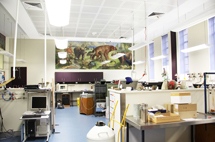- Home
- Facilities
Facilities
 |
| Inside the Stable Isotope Geochemistry Laboratory |
In 2003 the laboratory was relocated from the Steele building to the Richards building and into the space that was once the original Geology museum.
The heritage listed original murals of Australian megafauna and dinosaurs were preserved giving us a uniquely decorated open plan workspace. The laboratory is housed in the same building as the Earth Sciences Argon dating facility, the Geochemistry laboratory and the CMM Radiogenic Isotope Facility. We have a suite of modern mass spectrometers and assorted off-line vacuum sample preparation systems. Currently we offer stable isotopic analysis of C, O, H and S.
| Facilities section | |||
|---|---|---|---|
Isoprime Mass Spectrometer with Elementar Elemental Analyser (EA-IRMS)Isoprime Continuous Flow Mass Spectrometer with Elemental Analyser and Laser (EA-CF-IRMS) This continuous flow instrument is used for organic carbon and sulfur isotope analysis. Included in this is the simultaneous measurement of sulfur 33 and sulfur 34 isotopes required for research on mass independent fractionation. |
|||
Isoprime DI MultiprepIsoprime Dual Inlet Mass Spectrometer with Multiprep (DI-IRMS) This dual inlet with multiprep bench is currently used for analysis of carbonates (C, O); and waters (D, O). It is also set up with a single sample inlet which enables the analysis of gases produced from the off-line systems such as the mineral hydrogen line and the carbonate line. |
|||
Thermo Delta V AdvantageThermo Delta V Advantage Continuous Flow mass spectrometer with Thermal combustion elemental analyser and liquids and solid zero blank autosamplers (CF-TC/EA IRMS) Used for quick simultaneous analysis of D and O on waters and D/H analysis on solid samples such as clay species. |
|||
Isoprime GC-c-IRMSCombustion isotope ratio mass spectrometer -(GC-c-IRMS) Brand new instrument currently being installed will allow us to identify mixtures of various mine gases and to perform stable isotope analysis on these different species such as methane, carbon dioxide, hydrogen and the lower ranked hydrocarbons. |
|||
Carbonate Extraction LineFor analysis of siderite, dolomite and impure carbonate samples |
|||
Mineral Hydrogen and Fluid Inclusions Extraction LineA radio frequency generator is used to crack the fluid inclusions in quartz samples and also to fuse clay minerals for D/H analysis |
|||
Shared FacilitiesRock Preparation Laboratory - UQ Earth Sciences: Rock crushing, mineral separation, thin sectionsGeochemistry Laboratory - UQ Earth Sciences: ICP-OES, Trace and Major Element Analysis Centre for Microscopy and Micro Analysis: TEM, SEM, EDS, microprobe, XRD Radiogenic Isotope Facility with ICP-MS , TIMS and multicollector |
|||
